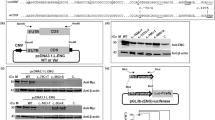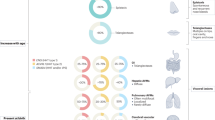Abstract
Hereditary hemorrhagic telangiectasia (HHT) is an autosomal dominant disease characterized by widespread arteriovenous malformations and caused by mutations in two major genes: ENG and ACVRL1. Two decades ago, a French epidemiological study pointed out that its prevalence was higher than previously thought and that its distribution varied greatly from one area to another, one of the highest concentrations of patients being found in the Haut-Jura mountains. Although germline mutations are usually family specific, some of them have been reported in unrelated patients, especially for ACVRL1. We performed haplotype analysis of 116 French and Italian patients carrying 13 ACVRL1 different mutations. For five of these mutations, we estimated the age of the most recent common ancestors (MRCAs) using the ESTIAGE program. Most mutations were related to both recurrent mutational events and founder effects with age estimates ranging from 100 to 550 years. The c.1112dupG mutation, which is likely to be responsible for the very high concentration of HHT patients found in the former epidemiological study, probably occurred in one inhabitant of the Haut-Jura Mountains more than three centuries ago. The p.Arg374Gln mutation occurred independently in at least two distinct geographical areas, including the area with the second highest prevalence in the epidemiological study and where the MRCA is rather recent (about 100 years ago). Partially shared haplotypes between French and Italian patients were found for three mutations. This suggests a common origin and a possible diffusion of these mutations from Italy to France.
Similar content being viewed by others
Log in or create a free account to read this content
Gain free access to this article, as well as selected content from this journal and more on nature.com
or
References
Plauchu H, de Chadarevian JP, Bideau A, Robert JM : Age-related clinical profile of hereditary hemorrhagic telangiectasia in an epidemiologically recruited population. Am J Med Genet 1989; 32: 291–297.
McAllister KA, Grogg KM, Johnson DW et al: Endoglin, a TGF-β binding protein of endothelial cells, is the gene for hereditary haemorrhagic telangiectasia type 1. Nat Genet 1994; 8: 345–351.
Johnson DW, Berg JN, Gallione CJ et al: A second locus for hereditary hemorrhagic telangiectasia maps to chromosome 12. Genome Res 1995; 5: 21–28.
Oh SP, Seki T, Goss KA et al: Activin receptor-like kinase 1 modulates transforming growth factor-β1 signaling in the regulation of angiogenesis. Proc Natl Acad Sci USA 2000; 97: 2626–2631.
Goumans MJ, Valdimarsdottir G, Itoh S, Rosendahl A, Sideras P, ten Dijke P : Balancing the activation state of the endothelium via two distinct TGF-β type I receptors. EMBO J 2002; 21: 1743–1753.
Gallione CJ, Repetto GM, Legius E et al: A combined syndrome of juvenile polyposis and hereditary hemorrhagic telangiectasia associated with mutations in MADH4 (SMAD4). Lancet 2004; 363: 852–859.
Cole SG, Begbie ME, Wallace GM, Shovlin CL : A new locus for hereditary haemorrhagic telangiectasia (HHT3) maps to chromosome 5. J Med Genet 2005; 42: 577–582.
Bayrak-Toydemir P, McDonald J, Akarsu N et al: A fourth locus for hereditary hemorrhagic telangiectasia maps to chromosome 7. Am J Med Genet A 2006; 140: 2155–2162.
Lesca G, Burnichon N, Raux G et al: Distribution of ENG and ACVRL1 (ALK1) mutations in French HHT patients. Hum Mutat 2006; 27: 598.
Lesca G, Plauchu H, Coulet F et al: Molecular screening of ALK1/ACVRL1 and ENG genes in hereditary hemorrhagic telangiectasia in France. Hum Mutat 2004; 23: 289–299.
Bideau A, Plauchu H, Brunet G, Robert J : Epidemiological investigation of Rendu-Osler disease in France: its geographical distribution and prevalence. Popul 1989; 44: 3–22.
Kjeldsen AD, Vase P, Green A : Hereditary haemorrhagic telangiectasia: a population-based study of prevalence and mortality in Danish patients. J Intern Med 1999; 245: 31–39.
Dakeishi M, Shioya T, Wada Y et al: Genetic epidemiology of hereditary haemorrhagic telangiectasia in a local community in the northern part of Japan. Hum Mutat 2002; 19: 140–148.
Olivieri C, Mira E, Delù G et al: Identification of 13 new mutations in the ACVRL1 gene in a group of 52 unselected Italian patients affected by hereditary haemorrhagic telangiectasia. J Med Genet 2002; 39: e39.
Génin E, Tullio-Pelet A, Begeot F, Lyonnet S, Abel L : Estimating the age of rare disease mutations: the example of Triple-A syndrome. J Med Genet 2004; 41: 445–449.
Bayrak-Toydemir P, McDonald J, Markewitz B et al: Genotype–phenotype correlation in hereditary hemorrhagic telangiectasia: mutations and manifestations. Am J Med Genet A 2006; 140: 463–470.
Cooper DN, Youssoufian H : The CpG dinucleotide and human genetic disease. Hum Genet 1988; 78: 151–155.
Heyer E, Brunet G : Généalogie et structure génétique de la population; in Bideau A, Brunet G (eds): Essai de démographie historique et de génétique des populations. Paris: Une population du Jura méridional du XVIIe siècle à nos jours, 2007, pp 159–171.
Brusgaard K, Kjeldsen AD, Poulsen L et al: Mutations in endoglin and in activin receptor-like kinase 1 among Danish patients with hereditary haemorrhagic telangiectasia. Clin Genet 2004; 66: 556–561.
Gallione CJ, Scheessele EA, Reinhardt D et al: Two common endoglin mutations in families with hereditary hemorrhagic telangiectasia in the Netherlands Antilles: evidence for a founder effect. Hum Genet 2000; 107: 40–44.
Stephens M, Smith NJ, Donnelly P : A new statistical method for haplotype reconstruction from population data. Am J Hum Genet 2001; 68: 978–989.
Rosenberg NA, Hirsch AE : On the use of star-shapes genealogies in inference of coalescence times. Genetics 2003; 164: 1677–1682.
Hanein S, Perrault I, Gerber S et al: Population history and infrequent mutations: how old is a rare mutation? GUCY2D as a worked example. Eur J Hum Genet 2008; 16: 115–123.
Acknowledgements
We thank the patients and their colleagues from the French-Italian HHT Network who referred the patients. This work was supported by the following sources of funding: Fondation pour la Recherche Médicale, Rare Disease Network financed by INSERM and AFM (Association Française contre les Myopathies), Projet Hospitalier de Recherche Clinique 27-2004 (French Ministry of Health) and Fondazione Banca del Monte di Lombardia (Pavia, Italy).
Author information
Authors and Affiliations
Consortia
Corresponding author
Additional information
Supplementary Information accompanies the paper on European Journal of Human Genetics website (http://www.nature.com/ejhg)
Supplementary information
Rights and permissions
About this article
Cite this article
Lesca, G., Genin, E., Blachier, C. et al. Hereditary hemorrhagic telangiectasia: evidence for regional founder effects of ACVRL1 mutations in French and Italian patients. Eur J Hum Genet 16, 742–749 (2008). https://doi.org/10.1038/ejhg.2008.3
Received:
Revised:
Accepted:
Published:
Issue date:
DOI: https://doi.org/10.1038/ejhg.2008.3
Keywords
This article is cited by
-
Sequence variations of ACVRL1 play a critical role in hepatic vascular malformations in hereditary hemorrhagic telangiectasia
Orphanet Journal of Rare Diseases (2020)
-
Future treatments for hereditary hemorrhagic telangiectasia
Orphanet Journal of Rare Diseases (2020)
-
The Stratified Population Screening of Hereditary Hemorrhagic Telangiectasia
Pathology & Oncology Research (2020)
-
Mutation affecting the proximal promoter of Endoglin as the origin of hereditary hemorrhagic telangiectasia type 1
BMC Medical Genetics (2017)
-
Increase of circulating endothelial cells in patients with Hereditary Hemorrhagic Telangiectasia
International Journal of Hematology (2015)



